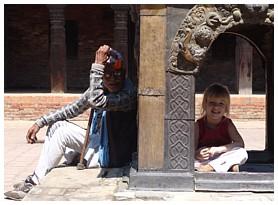|
|
|
|
|
|
|
|
|
|
|
|
|
|
|
|
|
|
|
|
|
|
|
|
|
|
| |
WORLDCOOK'S TRAVELS - KATHMANDU (Nepal) |
|
|
|
Recipes from Nepal |
|
Travel to Nepal |
|
Travel to other countries |
|
Nepal is squeezed
in between India and
China/Tibet and has more than 27 million inhabitants
(2006), most of them Hindus, with Buddhists on the second place.
They have a flag, which you will never forget, if you have seen it once. Most
countries in the world have a rectangular flag. Some countries are a bit
more daring and have a square one. But
Nepal is the
only one with a completely different flag, consisting of two triangles.
According to legends, thousands of years ago there were two mythological
kings, one came from cow herders, who descended from the moon (Gopalas),
the other was from a group of buffalo herders, who descended from the sun
(Masipalas). Therefore, both sun and moon are represented in the flag. No
historical evidence has been found for the story, but it is still a
beautiful flag. |
|
Kathmandu, the capital of Nepal, is situated at an altitude of 1,336 meters. The city has about 700,000 inhabitants. In the Kathmandu valley, you can also find the historical cities Patan and Bhaktapur. Politics have been as turbulent in Nepal as the weather in the Nepali mountains. Until approximately 1700, the country was often in the hands of another country, or divided between kings and tribal heads. In Kathmandu valley, the area was split up in three small kingdoms. Even though Nepal is much bigger than only this valley, the distances outside were long and the roads difficult to travel, so Kathmandu valley was what Nepal was all about, and the kings were the most powerful of all. Of one of the kingdoms, Patan, you can still find beautiful and well kept or well restored memories. |
 |
|
Patan is on the list of "world heritages" of
UNESCO. As a result, it is a protected pedestrian zone and no traffic is
allowed in. There are beautiful palaces and temples, and a lot of
exquisite wood carving. There is also a Krishna temple.
Krishna likes animals but not
animal offers, and therefore the animals inside the temple square are
alive, and mooing, bleating, cackling and shitting. It is a small square
and it is full of Krishna devotees. Offers are made, but they are all
vegetarian, and mainly bananas, still in the peel. The burning of those
bananas creates a thick black smoke, which hurts your eyes and remembers
you of the smell of burning rubber tires. |
|
|
|
One of the
temples in Kathmandu is called “Pashupathi Nath”. It is dedicated to Shiva
and death reigns in all forms. Tourists stand on one side of the river,
which is reduced to a small muddy stream, while on the other side
cremations are carried out like in a theater but without pause for
popcorn. |
|
Another famous temple we visit is the Boudhanat temple, a Buddhist temple, as the name already promises, which is very popular with Tibetans, many of whom came to Nepal to escape the Chinese pressure. The temple rises to the sky as a snow white dome from the red brick houses around it. The street around it is lined with stalls, displaying items of copper, reflecting the bright sunlight to the tourist in the hope they may be convinced to buy, totally neglected by the white cows that slowly walk around the temple. Happily colored flags are all around us and music sounds from every shop. Merchants try to sell us mini-violins, which look like only a person with mini-brains would like to play them; or a small child perhaps, because Anna really likes them. Another thing that is on sale almost everywhere are pictures from the Kamasutra. Tiny men emerge whispering from dark corners and try to sell their attractive booklets not only to me, but also to my poor children, thus totally neglecting the filters we put on the internet to avoid the appearance of poorly dressed women. |
|
|
|
Kathmandu used to be very
popular with hippies and other users of hashish in the 1960s and 1970s. In
fact, you see many middle-aged hippies still hanging around, as a sort of
wilted flower power, especially around "Freak Street". The same street has
been called "Pilgrim Trail", "Hashish Trail" and "Hippie Trail".
Apart from the hippies themselves, the street is not much different from
other streets in the neighborhood, with souvenir shops, carpets and
trekking gear on sale. |